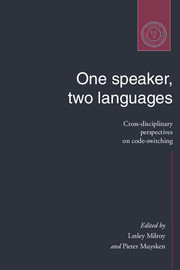Book contents
- Frontmatter
- Contents
- Notes on contributors
- Acknowledgments
- 1 Introduction: code-switching and bilingualism research
- Part one Code-switching in institutional and community settings
- 2 Bilingual speech of migrant people
- 3 Code-switching in the context of dialect/standard language relations
- 4 Code-switching in community, regional and national repertoires: the myth of the discreteness of linguistic systems
- 5 Code-switching in the classroom: two decades of research
- Part two Code-switching and social life
- Part three Grammatical constraints on code-switching
- Part four Code-switching in bilingual development and processing
- Index
5 - Code-switching in the classroom: two decades of research
Published online by Cambridge University Press: 05 June 2012
- Frontmatter
- Contents
- Notes on contributors
- Acknowledgments
- 1 Introduction: code-switching and bilingualism research
- Part one Code-switching in institutional and community settings
- 2 Bilingual speech of migrant people
- 3 Code-switching in the context of dialect/standard language relations
- 4 Code-switching in community, regional and national repertoires: the myth of the discreteness of linguistic systems
- 5 Code-switching in the classroom: two decades of research
- Part two Code-switching and social life
- Part three Grammatical constraints on code-switching
- Part four Code-switching in bilingual development and processing
- Index
Summary
Research on code-switching in bilingual classrooms now spans almost two decades. It has been cross-disciplinary in nature and has thus reflected different currents of influence: from educational research on classroom interaction and teacher talk styles and, more recently, from conversational analysis, pragmatics and the ethnography of communication. It has also been international in nature: the early studies were carried out in the United States in bilingual education programmes for linguistic minority children. The 1970s and early 1980s saw the development of a substantial body of classroom-based research in this particular context. However, since the early 1980s, research on bilingual classroom processes has also been undertaken in other bilingual and multilingual settings such as Canada, South America, Europe, Africa and South East Asia.
Most research has been undertaken in settings where there is an ongoing debate about language education policy: in situations where a new form of language education programme has been implemented or where there has been a change in the medium of instruction or, in contrast, in situations where a change in medium needs to be considered because current policies are inappropriate. The principal motivation in undertaking most classroom-based research seems to have been to establish how language education policies are being translated into communicative practice in the day-to-day cycles of classroom life. As Merritt et al. have pointed out: ‘Determinants of language choice and code-switching in the classroom are necessarily more complex than can be “legislated” by language policy on medium of instruction’ (1992: 105).
Information
- Type
- Chapter
- Information
- One Speaker, Two LanguagesCross-Disciplinary Perspectives on Code-Switching, pp. 90 - 112Publisher: Cambridge University PressPrint publication year: 1995
Accessibility standard: Unknown
Why this information is here
This section outlines the accessibility features of this content - including support for screen readers, full keyboard navigation and high-contrast display options. This may not be relevant for you.Accessibility Information
- 61
- Cited by
